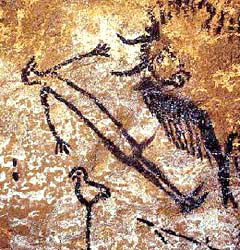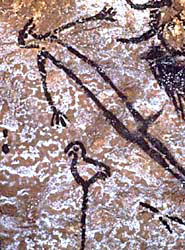|

from
365Articles Website
|
A
suspected black hole in Cygnus constellation thought to
be source of cosmic rays that changed evolution and
kickstarted religion
Excerpts from
An Interview with Andrew
Collins by Brent Raynes
Editor: Let’s
talk a little more about your upcoming book The
Cygnus Mystery.
Andrew Collins: Right. My current project is
The Cygnus Mystery. Cosmic rays from the Cygnus
constellation influenced human evolution in early
history and affected human behavior and caused
germ-like mutations over a longer period of time,
probably about 2000 years. Now this might seem a
whacky idea but as I was writing the book I
discovered that a scientific think tank, known as
the Meinel Institute of Las Vegas announced that
they also now believe that something similar was
going on in paleolithic times.
Their candidate is a
planetary nebula in the constellation of Draco,
which is next door to Cygnus. Very, very close. This
they worked out through an examination of the levels
of Beryllium-10, which is a bi-product of cosmic
rays hitting the upper atmosphere and changing
oxygen and nitrogen into the secondary element of
beryllium. Which falls to the earth and is retained
within sea levels and ice cores, and measurements of
this can determine the level of cosmic rays.
There’s no question
that towards the end of the paleolithic era the
level of cosmic rays hitting the earth had doubled.
So to suggest that this may have been involved in
mutations leading in changes to human evolution is
not a mad idea. Plus I found out that as early as
1972,
Carl Sagan, the great scientific writer, spoke
about exactly the same thing, the idea of cosmic
rays influencing human evolution, in his book The
Cosmic Connection. He went back to the subject in
1977 in his book
The Dragons of Eden.
It’s something that I believe influenced the
foundations of world religions as well. You will
find this Cygnus link within Christianity, within
Islam, within Hinduism, within Near Eastern
religions like Mandaeans of Iraq and Iran, the
Sabians, the Chaldeans of the Bible, even certain
Shiite Islamic groups strongly related to this. It’s
behind the whole concept that heaven was in the
north and that we come from the sky and that we
return there in death.
Somehow this is all
mixed up with this whole idea of cosmic rays
influencing human evolution, influencing human
intelligence, but mixed up with the whole idea of
panspermia as well. This connection with the cosmos.
Something which is very, very important, and I think
that as we go on we will begin to realize that it is
more and more important.
|
Since the discovery in the 1920s that all types of radiation can
cause gene mutations, scientists have wondered what role high energy
cosmic rays might have played in human evolution. However, it was an
idea destined never to find favour among geneticists, who could
determine no hard evidence that the background flux of cosmic rays
might have had any noticeable effect on human cells.
All this is about to change, as an examination of ice cores
extracted from sites in Antarctica and Greenland provides new
information on the level of cosmic rays reaching Earth in past ages.
When so-called ‘primary’ cosmic rays hit the upper atmosphere they
generally break up to produce a plethora of ‘secondary’ particles
that form isotopes, which fall to Earth and are preserved each year
in layers of ice. One such isotope is beryllium 10, which provides
clear evidence that on three occasions over the past 100,000 years –
around 60,000 years ago, 40,000 years ago and 17,000 years ago -
there have been extremely intense periods of cosmic ray activity
lasting up to 2,000 years at a time.
Although the cyclic nature of these spikes of activity perhaps
indicate a connection with long-term solar cycles, other factors
might have been behind the sudden increase in cosmic rays during
Palaeolithic times, when our earliest ancestors made huge jumps in
evolution that led eventually to the rise of civilization.
Catastrophists propose that a close supernova explosion might have
sent a barrage of cosmic particles in our direction, dramatically
increasing cloud formation, thus preventing the sun from penetrating
through the atmosphere and leading quickly to an ice age and mass
extinctions on the ground. Thus it is possible that close supernova
might account for the high levels of beryllium found in the ice
cores.
An altogether different scenario is that the true source of cosmic
rays affecting the evolution of life are black holes or neutron
stars, a theory first proposed in 1973 by world-renowned astronomer
Carl Sagan. Curiously, in the 1980s particle physicists in Europe
and the USA unexpectedly detected the presence deep underground of
incoming cosmic rays that had penetrated the solid rock to great
depths, suggesting that they had come from an extremely powerful
cosmic ray accelerator somewhere in deep space.
These unique cosmic rays were found to have been produced by a
binary star system containing either a black hole or neutron star in
the northern constellation of Cygnus, the swan. Known as Cygnus X-3,
it was classified as recently as 2000 as the galaxy’s first ‘blazar’,
meaning that it produces jets of plasma, or ionized gas, that direct
cosmic particles towards the Earth at close to the speed of light,
something it has been doing for anything up to 700,000 years.
The recorded bursts of cosmic radiation from deep space on at least
three occasions in human history could suggest that Cygnus X-3 is
the key to solving the mystery of the cosmic rays.
-
Had the
Palaeolithic cave artists and shamans responsible for the cave art
at Lascaux, and other similar caves across Western Europe, become
aware of incoming cosmic rays, which are unique in being able to
penetrate deep underground?
-
Did these cygnets, as Cygnus X-3’s
strange particles became known, cause gene mutations, leading
eventually to the development of a complex mindset, including
symbolic art and the first organized societies towards the end of
the last Ice Age?
Cygnus is the oldest known constellation represented in art,
appearing as a bird on a pole in the famous cave of Lascaux in
southern France, c.17,000 years ago. What is more, all around the
world there was once a great reverence of this constellation, known
also as the Northern Cross.

 
From the bird effigy mounds of North
America to the Olmec centers of Mexico, the Incan sacred city of
Cuzco, the Egyptian Pyramids of Giza, the Hindu temples of India to
Avebury, the largest stone circle in Europe - all reflect an age-old
interest in Cygnus, which features also in religious symbolism and
beliefs, at the heart of Judaism, Christianity, Hinduism, Islam, as
well as shamanic practices worldwide.
All of this indicates that
Cygnus X-3, as our galaxy’s sole blazar, is the best candidate by
far for at least a percentage of the cosmic radiation that continues
to reach Earth and may well have catalyzed mutations leading in the
past to sudden advances in human evolution.
|



